Get Inspired By These 7 Nonprofit Advertising Examples

In 2024, nonprofit spending on digital ads increased by 11%, with organizations investing $0.14 in digital ads for every dollar of online revenue earned. This increased investment proved to be a wise decision—search advertising and multi-channel ad formats generated remarkably strong returns of $2.23 and $1.49, respectively.
However, revenue-generating ad campaigns don’t happen by accident. They’re the result of deep audience research, careful planning, and compelling, mission-aligned messaging. You’ll need to identify who to target and what inspires them to give, then pinpoint the best ways to get your message in front of them.
Want to create your own nonprofit advertising campaigns? Allegiance Group + Pursuant can turn your inspiration into action.
What is nonprofit advertising?
Nonprofit advertising involves using paid channels, such as paid search or social media ads, to promote your mission, bring more attention to your fundraisers, or attract various forms of support. Advertising is a specific tactic or component of marketing, which is broader and encompasses your organization’s overall promotion strategy.
While advertising is effective for increasing awareness and visibility, keep in mind that it can be used to support each phase of the donor intent funnel. For example, a Facebook ad can attract curious prospects by emphasizing the problem you’re confronting and forming an emotional connection. Then, retargeting ads can direct more urgent asks with a specific call to action (e.g., donating) to high-intent prospects who clicked through on previous ads.
What makes nonprofit advertising campaigns successful?
Effective ad campaigns are intentional and strategic, supporting and amplifying your broader marketing efforts and organizational priorities. While each campaign is different, aiming to include the following elements will put you on the right track to high-converting advertisements:
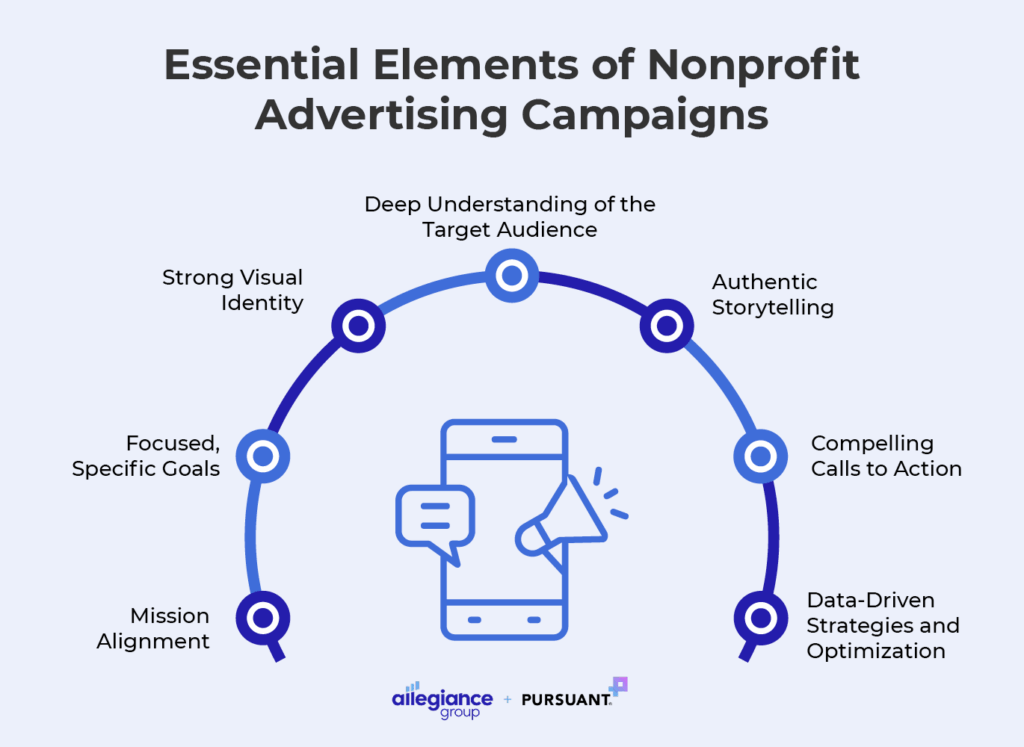
- Mission alignment. Ensure each campaign, strategy, and individual message or creative asset is directly tied to your mission. This boosts trust and consistency from supporters’ perspectives and allows your nonprofit to better coordinate its efforts across channels.
- Focused, specific goals. Your campaigns should also each have a specific, measurable goal that furthers your mission in some way. This could be attracting 500 new donors or increasing fundraising revenue by 30%.
- Strong visual identity. Supporters should instantly recognize your organization’s messages, no matter the format or channel. Use unified brand elements (e.g., colors, logo, typography) and images or graphics that convey emotion and impact.
- Deep understanding of the target audience. Know who you’re speaking to and dig into their giving history, motivations, interests, and demographics. Create donor segments, tailoring messaging and channel use accordingly.
- Authentic storytelling. Use narrative formats to communicate what your nonprofit does and its impact on beneficiaries. Build emotional connections by featuring real stories, humanizing your cause, and presenting the tangible results of your work.
- Compelling calls to action (CTAs). CTAs explain what supporters should do to get involved and support your cause, whether that’s asking them to “Donate Now” or “Become a Volunteer.” Make your CTAs punchy, actionable, and straightforward to boost conversions.
- Data-driven strategies and optimization. Without data, you’re relying on assumptions and guesswork. Use audience research and data about past campaign performance to plan your approach. Then, carefully track the campaign’s performance and identify opportunities to hone your strategies.
Remember that maintaining transparency and cultivating trust among supporters should always come first. Americans’ trust in nonprofit organizations has stagnated at 57%, underscoring that organizations need to take extra steps to clearly and openly communicate. In the context of nonprofit advertising, this means being inclusive and respectful, avoiding misleading or sensationalized messaging, and engaging in ethical storytelling.
Get interview techniques, photography tips, and practical strategies to make your community’s stories shine
7 Nonprofit Advertising Examples
Inspiring Ads By Our Team
Our team at Allegiance Group + Pursuant (AGP) leverages its decades of experience in the nonprofit sector. We specialize in delivering full-funnel marketing and fundraising strategies that inspire donors and turn them into passionate champions for your cause. Our services include:
- Digital marketing
- Direct mail fundraising
- Web and app development
- Strategy and planning
- UX, brand, and design
- Analytics and insights
Nonprofit advertising is a vital component of our digital marketing services. We write ad copy, design graphics, and deploy digital ads. Additionally, our team of experienced media experts manages various paid media solutions, from social media ads to traditional offline media partnerships.
If you want to see some real ads at work, we’ve highlighted some nonprofit advertising campaigns from our clients:
1. Fulfill Food Bank
Fulfill Food Bank has been working for more than 40 years to end hunger and address barriers to self-sufficiency in Monmouth and Ocean Counties, New Jersey. Like many other food banks across the nation, Fulfill Food Bank has faced funding cuts, inflation, and economic uncertainty.
In response to these pressures, Fulfill worked with AGP to launch a targeted paid social campaign. Because federal funding cuts can be a polarizing message, Fulfill needed a way to adjust messaging depending on the supporters’ ideology.
Using AGP’s GivingDNA audience data, Fulfill was able to segment its audience by political affiliation and deploy tailored messaging to each group. All audiences received messages focused on rallying community support. Democrats received a “hard” message about the impact of federal funding cuts, while republicans, independents, and other prospects received softer messaging focused on the impact of unexpected funding issues.
As a result, Fulfill experienced a cost per acquisition (CPA) of $37.86—the lowest of any Fulfill campaign and 151% lower than the industry benchmark. Prospects were the top-performing audience, and the Republican/Independent/Unaffiliated audience produced the highest average gift ($104.29).
Key takeaways from this campaign:
- Segmentation is context-dependent and should aim to meet all supporters where they are without excluding anyone.
- Investing the time and money into data-driven strategies upfront leads to lower costs in the long run.
- With some creativity, crises and setbacks can be opportunities to rally support and bring communities together.
2. Washington National Cathedral
The Washington National Cathedral (WNC), also known as the “Nation’s Church,” is the cathedral of the Episcopal Diocese located in Washington, D.C. In September 2024, WNC worked with AGP to launch its first-ever Giving Day, which was timed to coincide with Cathedral Day. The initiative called on WNC’s community to support its historic, comprehensive campaign called “A Cathedral for the Future.”.
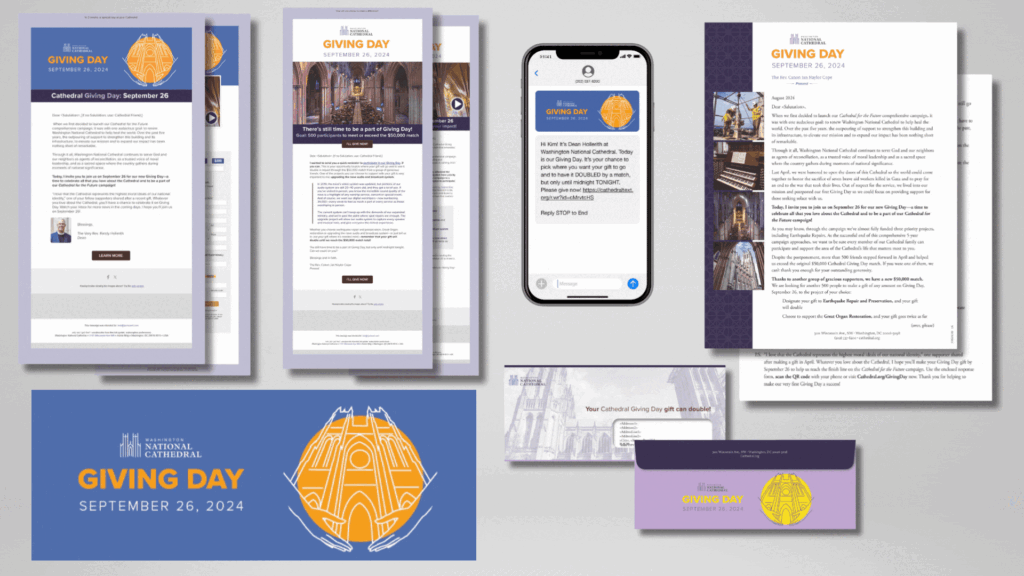
The goals of this campaign were to raise awareness of the Cathedral’s needs, increase engagement, and drive donations. Our team developed an omni-channel approach that leveraged social media advertising in conjunction with direct mail appeals, emails, a website landing page, voice broadcast phone calls, and SMS outreach. WNC also gave donors the option to decide where their donations went.
WNC’s goal for the campaign was to secure $50,000 from 500 donors, and it exceeded both of these goals by more than 450% and 140%, respectively. Additionally, the momentum from this campaign continued through the end of the year with strong support from donors.
Key takeaways from this campaign:
- Clear goals allowed WNC to clearly measure the success of these efforts.
- An integrated, omni-channel approach seamlessly guided donors from the first touch to conversion.
- Allowing donors to choose how their contributions are used enhanced trust and engagement.
3. Georgia Mountain Food Bank
The Georgia Mountain Food Bank (GMFB) is a nonprofit organization located in northeast Georgia dedicated to addressing food insecurity in its community. Although GMFB had an existing base of active supporters, it wanted to expand its digital reach and connect more deeply with supporters. GMFB and AGP were already working together on direct mail campaigns, but this new push for digital expansion opened the door to a digital advertising strategy.
To get started, our team built out the technical foundation for the campaign (e.g., setting up ad accounts, ensuring tracking was in place). Then, we conducted a knowledge-sharing session to gather insights that informed the final advertising strategy to attract new donors and re-engage existing ones. Over the course of two months, our team implemented paid search ads on Google and Microsoft, as well as display advertising on Facebook and Instagram to support all other GMFB marketing efforts.
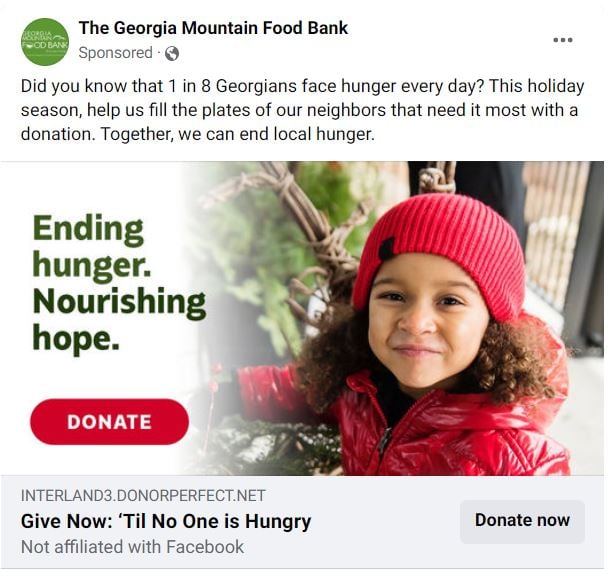
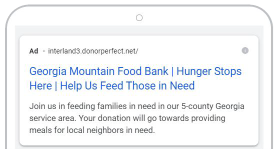
The paid search campaign delivered excellent results with a strong return on ad spend (ROAS) of 200%. This particular campaign attracted a total of 142 donations, averaging $257.69.
Key takeaways from this campaign:
- Taking the time to set up a strong technical foundation is key to getting granular insights needed to measure performance and optimize future campaigns.
- Using a mix of search and social ads to support established, ongoing marketing activities.
- Leveraging the experience and knowledge from key nonprofit stakeholders and our team of marketers to understand the target audience.
Nonprofit Advertising Campaigns That Inspire Us
4. Nonprofits Get It Done
The National Council of Nonprofits (NCN) is a network of North American nonprofit organizations. In August 2025, NCN launched a national advertising campaign titled “Nonprofits Get It Done” that aimed to highlight the work nonprofits do and reinforce their central role in American life. The campaign used bold text and images from real organizations to spotlight specific ways nonprofits fill in gaps in public needs, clean up after natural disasters, and more.
NCN created a dedicated campaign website and a campaign hashtag (#NonprofitsGetItDone) to amplify reach online.

What we like about this campaign: NCN shared a message that united all nonprofits while still focusing on changing public perception of nonprofits (i.e., solidifying that they are essential economic and community drivers).
5. #EndangeredEmoji Campaign
The World Wildlife Fund (WWF) is a conservation organization committed to protecting nature and biodiversity. The organization launched a social media campaign known as the #EndangeredEmoji campaign that harnessed posting on Twitter (now X) as a donation mechanism. Users were encouraged to retweet an image of 17 endangered animals in emoji form.
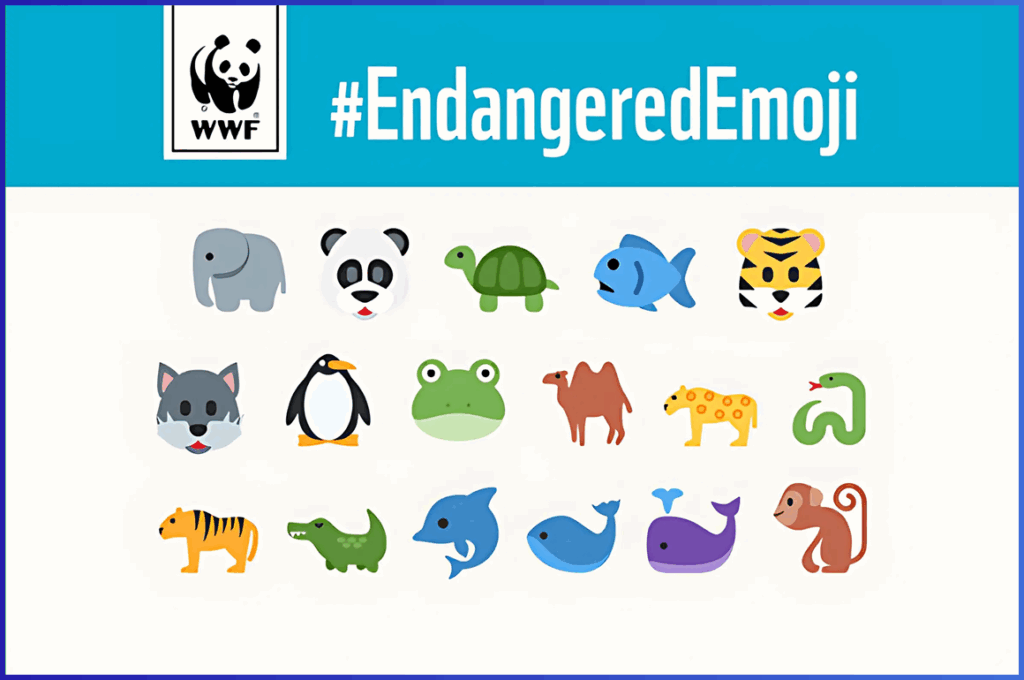
As outlined in this video from WWF, users were asked to post using the endangered emojis. At the end of the month, they were sent a report tallying how many times they used the emojis. From there, they could choose how much to donate to the organization.
What we like about this campaign: The #EndangeredEmoji campaign leveraged accessible, digital language and a unique call to action to engage existing supporters and prospects on social media.
6. #20PercentCounts
Lean In, a nonprofit that helps create equal and inclusive workplaces for women, organized the #20PercentCounts campaign to raise awareness of the gender pay gap. To grab viewers’ attention, it used the statistic that, on average, women make about 20% less than men. From there, the campaign issued a unique call to action, challenging businesses to offer a 20% off promotion on Equal Pay Day. This made the abstract concept of the gender pay gap more tangible.
What we like about this campaign: Honing in on a striking, highly relevant statistic created a memorable hook for the campaign. Tying the statistic into the call to action made the campaign feel more cohesive and brought the statistic to life.
7. Love Has No Labels
The Ad Council is a nonprofit organization that creates advertising campaigns around critical social issues. The organization is responsible for some of the most iconic campaigns, including Smokey Bear and Friends Don’t Let Friends Drive Drunk.
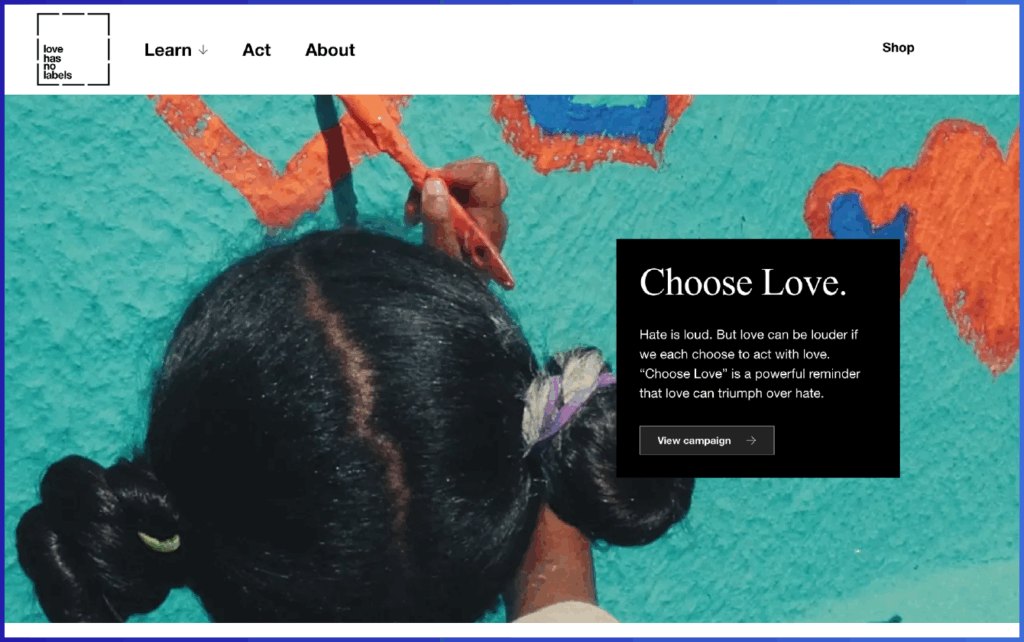
The Ad Council’s Love Has No Labels campaign supported equality for all Americans, framing love as a powerful force that can bring people together. The campaign aimed to open and change audience members’ minds, celebrate diverse friendships and families, and forge new connections. The wide-sweeping campaign includes a campaign website as well as a variety of creative assets that aired across the following channels:
- Television
- Radio
- Banner
- Out of home
- Online video
While the campaign kicked off in 2015, it is still ongoing. The most recent push focused on the power of choosing love over hate.
What we like about this campaign: This campaign is an excellent example of using storytelling to humanize your mission. Additionally, it uses multiple communication channels to effectively expand its reach to new audiences.
Additional Resources
Nonprofit advertising is essential for cutting through crowded digital landscapes and engaging your supporters. However, it can be difficult to know which tactics will generate the best returns on your advertising investment. Use these examples and key takeaways to inspire your own campaigns, but remember to always consider your supporters’ values and preferences first.
At AGP, we have years of experience in balancing effective advertising strategies with the unique needs of our nonprofit clients. Contact us today to learn more about our data-driven advertising services.
Explore these additional resources for more tips to improve your nonprofit’s communications:
- Discover Nonprofit Web Design Essentials + 5 Examples. Your ad campaigns drive supporters to your website—but then what? Get the tips you need to optimize your website design.
- Digital Fundraising: How to Make Your Efforts Successful. For the best results, pair your ad campaigns with these powerful digital fundraising strategies.
- How to Foster Loyal Support with a Mid-Level Giving Program. You could be missing out on revenue from an overlooked segment: mid-level donors. Uncover what makes these donors so special and how to foster long-term support.